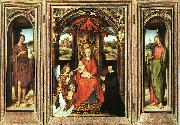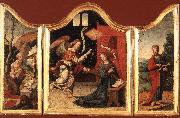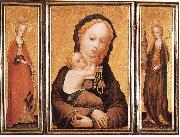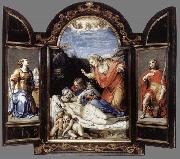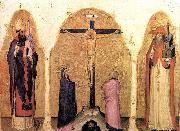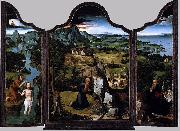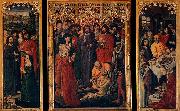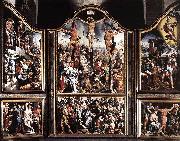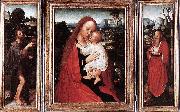Wholesale Oil Painting No Minimum |
|||||||||||
|
|
|||||||||||

|
|||||||||||
|
|
|
||||||||
Hans MemlingNetherlandish Northern Renaissance Painter, ca.1435-1494 Born in Seligenstadt, near Frankfurt in the Middle Rhein region, it is believed that Memling served his apprenticeship at Mainz or Cologne, and later worked in the Netherlands under Rogier van der Weyden (c. 1455?C1460). He then went to Bruges around 1465. There is an apocryphical story that he was a wounded at the Battle of Nancy, sheltered and cured by the Hospitallers at Bruges, and that to show his gratitude he refused payment for a picture he had painted for them. Memling did indeed paint for the Hospitallers, but he painted several pictures for them, in 1479 and 1480, and it is likely that he was known to his patrons of St John, prior to the Battle of Nancy. Memling is connected with military operations only in a distant sense. His name appears on a list of subscribers to the loan which was raised by Maximilian I of Austria, to defend against hostilities towards France in 1480. In 1477, when he was incorrectly claimed to have been killed, he was under contract to create an altarpiece for the gild-chapel of the booksellers of Bruges. This altarpiece, under the name of the Seven Griefs of Mary, is now in the Gallery of Turin. It is one of the fine creations of his more mature period. It is not inferior in any way to those of 1479 in the hospital of St. John, which for their part are hardly less interesting as illustrative of the master's power than The Last Judgment which can be found since the 1470s in the St. Mary's Church, Gda??sk. Critical opinion has been unanimous in assigning this altarpiece to Memling. This affirms that Memling was a resident and a skilled artist at Bruges in 1473; for the Last Judgment was undoubtedly painted and sold to a merchant at Bruges, who shipped it there on board of a vessel bound to the Mediterranean, which was captured by Danzig privateer Paul Beneke in that very year. This purchase of his pictures by an agent of the Medici demonstrates that he had a considerable reputation. |
||||||||
|
|
||||||||
Triptych
Triptych Painting ID:: 2953 |
1485
Art History Museum, Vienna 1485 Art History Museum, Vienna |
|||||||
|
|
||||||||
|
|
||||||||
|
|
Triptych
Triptych Painting ID:: 32200 |
Panel
Museo Cerralbo, Madrid Panel Museo Cerralbo, Madrid |
||||||
|
|
||||||||
MASTER of Saint VeronicaGerman Gothic Era Painter, active ca.1395-1420 |
||||||||
|
|
||||||||
|
|
Triptych
Triptych Painting ID:: 32425 |
1400-15
Tempera on wood, 58,9 x 39,5 cm 1400-15 Tempera on wood, 58,9 x 39,5 cm |
||||||
|
|
||||||||
BEER, Jan deNetherlandish Painter, ca.1475-1528 South Netherlandish painter and draughtsman. He is first mentioned in 1490 in the register of the Antwerp Guild of St Luke, apprenticed to the painter Gillis van Everen ( fl 1477-1513). In 1504 de Beer became a master. He subsequently served as alderman of the guild in 1509 and dean in 1515, although he found himself temperamentally unsuited to the position of dean, as is known from a lawsuit he filed in 1519 regarding guild administration. This document also reveals that de Beer participated in the preparations for Charles V's 'Joyous Entry' into Antwerp in 1515 and for the Antwerp Society of Rhetoricians' entry that year in the Malines landjuweel (regional competition of the rhetoricians). In 1510 and 1513 de Beer enrolled apprentices; his son Aert de Beer (c. 1509-before 6 Aug 1540) became an Antwerp master in 1529. The artist is undocumented between 1519 and 1528, by which date he was dead. In 1567 Guicciardini included de Beer in his list of famous Netherlandish painters. |
||||||||
|
|
||||||||
|
|
Triptych
Triptych Painting ID:: 62384 |
76,4 x 24,5 cm (each wing) Wallraf-Richartz Museum, Cologne Jan de Beer was a Flemish painter, one of the Antwerp Mannerist school many of whose paintings were formerly ascribed to him. The central panel depicts the Adoration of the Shepherds. On the left wing is St Felicity with her sons and on the right is St Ursula with her followers. The composition and style are characteristic of Antwerp Mannerism of the early 16th century. Author: BEER, Jan de Title: Triptych , 1501-1550 , Flemish Form: painting , religious 76,4 x 24,5 cm (each wing) Wallraf-Richartz Museum, Cologne Jan de Beer was a Flemish painter, one of the Antwerp Mannerist school many of whose paintings were formerly ascribed to him. The central panel depicts the Adoration of the Shepherds. On the left wing is St Felicity with her sons and on the right is St Ursula with her followers. The composition and style are characteristic of Antwerp Mannerism of the early 16th century. Author: BEER, Jan de Title: Triptych , 1501-1550 , Flemish Form: painting , religious |
||||||
|
|
||||||||
MASTER of Saint VeronicaGerman Gothic Era Painter, active ca.1395-1420 |
||||||||
|
|
||||||||
|
|
Triptych
Triptych Painting ID:: 63703 |
1410 Panel, 70 x 16 cm (each wing) Heinz Kisters Collection, Kreuzlingen It is unusual for the decoration on the backs of the wings to play an important thematic role in the visual programme of a triptych like this, but it does so in this case. When the triptych is closed one is presented with a moving depiction of Christ carrying the Cross, painted on a layer of red which was usually the support for gold leaf. Here the central motif has been isolated from the theme of the Carrying the Cross, which was of crucial importance for Late Medieval devotion. Having been isolated from the narrative, the image of the cross-bearing Christ acquires a validity unconnected with time or place.Artist:MASTER of Saint Veronica Title: Triptych (closed) Painted in 1401-1450 , German - - painting : religious 1410 Panel, 70 x 16 cm (each wing) Heinz Kisters Collection, Kreuzlingen It is unusual for the decoration on the backs of the wings to play an important thematic role in the visual programme of a triptych like this, but it does so in this case. When the triptych is closed one is presented with a moving depiction of Christ carrying the Cross, painted on a layer of red which was usually the support for gold leaf. Here the central motif has been isolated from the theme of the Carrying the Cross, which was of crucial importance for Late Medieval devotion. Having been isolated from the narrative, the image of the cross-bearing Christ acquires a validity unconnected with time or place.Artist:MASTER of Saint Veronica Title: Triptych (closed) Painted in 1401-1450 , German - - painting : religious |
||||||
|
|
||||||||
CARRACCI, AnnibaleItalian Baroque Era Painter, 1560-1609 Painter, draughtsman and printmaker, brother of Agostino Carracci. Since his lifetime, he has been considered one of the greatest Italian painters of his age. His masterpiece, the ceiling (1597-1601) of the Galleria Farnese, Rome, merges a vibrant naturalism with the formal language of classicism in a grand and monumental style. |
||||||||
|
|
||||||||
|
|
Triptych
Triptych Painting ID:: 63844 |
1604-05 Oil on copper and panel, 37 x 24 cm (central panel), 37 x 12 cm (each wing) Galleria Nazionale d'Arte Antica, Rome The central panel shows the Piet? while on the wings St Cecilia (left) and St Ermenegildus are represented. This small triptych originally belonged to Cardinal Odoardo Farnese, and the Farnese inventories document it as a work of Annibale Carracci as early as 1619. The attribution to Annibale was unquestioned until 1956 when, for stylistic reasons, the tabernacle was assigned to the Carracci workshop and given specifically to the hand of Innocenzo Tacconi. Despite this, the general conception of the work was attributed to Annibale on the basis of a drawing preserved at the Louvre (Paris). More recently, the documentary research has proven that the painting was commissioned directly from the artist by Cardinal Farnese sometime after 1603, the year in which he was obliged to renounce his claims to the succession to the English throne. Considering the importance of the commission, it seems difficult to argue against attribution to Carracci himself. The high quality of the Piet?and stylistic comparison of this central panel to Annibale's many other treatments of the subject lead to the assignment of this part of the execution to the master. It is, however, possible that Annibale allowed assistants (Innocenzo Tacconi or Antonio Carracci) to work on secondary panels, as these are slightly different in some of the details of execution.Artist:CARRACCI, Annibale Title: Triptych Painted in 1551-1600 , Italian - - painting : religious 1604-05 Oil on copper and panel, 37 x 24 cm (central panel), 37 x 12 cm (each wing) Galleria Nazionale d'Arte Antica, Rome The central panel shows the Piet? while on the wings St Cecilia (left) and St Ermenegildus are represented. This small triptych originally belonged to Cardinal Odoardo Farnese, and the Farnese inventories document it as a work of Annibale Carracci as early as 1619. The attribution to Annibale was unquestioned until 1956 when, for stylistic reasons, the tabernacle was assigned to the Carracci workshop and given specifically to the hand of Innocenzo Tacconi. Despite this, the general conception of the work was attributed to Annibale on the basis of a drawing preserved at the Louvre (Paris). More recently, the documentary research has proven that the painting was commissioned directly from the artist by Cardinal Farnese sometime after 1603, the year in which he was obliged to renounce his claims to the succession to the English throne. Considering the importance of the commission, it seems difficult to argue against attribution to Carracci himself. The high quality of the Piet?and stylistic comparison of this central panel to Annibale's many other treatments of the subject lead to the assignment of this part of the execution to the master. It is, however, possible that Annibale allowed assistants (Innocenzo Tacconi or Antonio Carracci) to work on secondary panels, as these are slightly different in some of the details of execution.Artist:CARRACCI, Annibale Title: Triptych Painted in 1551-1600 , Italian - - painting : religious |
||||||
|
|
||||||||
CARRACCI, AnnibaleItalian Baroque Era Painter, 1560-1609 Painter, draughtsman and printmaker, brother of Agostino Carracci. Since his lifetime, he has been considered one of the greatest Italian painters of his age. His masterpiece, the ceiling (1597-1601) of the Galleria Farnese, Rome, merges a vibrant naturalism with the formal language of classicism in a grand and monumental style. |
||||||||
|
|
||||||||
|
|
Triptych
Triptych Painting ID:: 63845 |
1604-05 Oil on copper and panel, 37 x 24 cm (closed) Galleria Nazionale d'Arte Antica, Rome The closed triptych represents St Michael the Archangel (left) and the Guardian Angel (right).Artist:CARRACCI, Annibale Title: Triptych Painted in 1551-1600 , Italian - - painting : religious 1604-05 Oil on copper and panel, 37 x 24 cm (closed) Galleria Nazionale d'Arte Antica, Rome The closed triptych represents St Michael the Archangel (left) and the Guardian Angel (right).Artist:CARRACCI, Annibale Title: Triptych Painted in 1551-1600 , Italian - - painting : religious |
||||||
|
|
||||||||
|
|
||||||||
|
|
Triptych
Triptych Painting ID:: 64922 |
45 x 56 cm Gallerie dell'Accademia, Venice Much more of an innovator than either Catarino or Lorenzo Veneziano was Jacobello Alberegno, who in the Triptych with Crucifixion and Saints, his only signed work, reveals himself to be an artist of penetrating refinement. If it is true that the two lateral saints, St Gregory and St Jerome, are examples of stylized Gothic figures, the images of the small central panel display a naturalness worthy of one of the best of Giotto's disciples. An extraordinary human dimension seems to govern the expression of sentiments in the picture: a grief-stricken St John the Evangelist clutches his cloak to his breast while the Virgin extends imploring arms and stares transfixed with anguish at her crucified son. , ALBEREGNO, Jacobello , Triptych , 1351-1400 , Italian , painting , religious 45 x 56 cm Gallerie dell'Accademia, Venice Much more of an innovator than either Catarino or Lorenzo Veneziano was Jacobello Alberegno, who in the Triptych with Crucifixion and Saints, his only signed work, reveals himself to be an artist of penetrating refinement. If it is true that the two lateral saints, St Gregory and St Jerome, are examples of stylized Gothic figures, the images of the small central panel display a naturalness worthy of one of the best of Giotto's disciples. An extraordinary human dimension seems to govern the expression of sentiments in the picture: a grief-stricken St John the Evangelist clutches his cloak to his breast while the Virgin extends imploring arms and stares transfixed with anguish at her crucified son. , ALBEREGNO, Jacobello , Triptych , 1351-1400 , Italian , painting , religious |
||||||
|
|
||||||||
|
|
||||||||
|
|
Triptych
Triptych Painting ID:: 65033 |
85,3 x 95 cm (central panel), 86,3 x 41 (wings) Wallraf-Richartz Museum, Cologne The painter of this altarpiece, the central panel of which depicting the extended Holy Family ('Holy Kinship') is referred to as The Elder Master of the Holy Kinship. , UNKNOWN MASTER, German , Triptych , 1401-1450 , German , painting , religious 85,3 x 95 cm (central panel), 86,3 x 41 (wings) Wallraf-Richartz Museum, Cologne The painter of this altarpiece, the central panel of which depicting the extended Holy Family ('Holy Kinship') is referred to as The Elder Master of the Holy Kinship. , UNKNOWN MASTER, German , Triptych , 1401-1450 , German , painting , religious |
||||||
|
|
||||||||
Joachim PatinirFlemish Northern Renaissance Painter, ca.1485-1524 |
||||||||
|
|
||||||||
|
|
Triptych
Triptych Painting ID:: 85153 |
Date c. 1520(1520)
Medium Oil on wood
Dimensions Height: 118 cm (46.5 in). Width: 81 cm (31.9 in). (central)
cjr Date c. 1520(1520) Medium Oil on wood Dimensions Height: 118 cm (46.5 in). Width: 81 cm (31.9 in). (central) cjr |
||||||
|
|
||||||||
Nicolas FromentFrench Early Renaissance Painter, ca.1430-1485 |
||||||||
|
|
||||||||
|
|
Triptych
Triptych Painting ID:: 85197 |
Date 1461(1461)
Medium Oil on wood
Dimensions Height: 175 cm (68.9 in). Width: 134 cm (52.8 in). (central)
cjr Date 1461(1461) Medium Oil on wood Dimensions Height: 175 cm (68.9 in). Width: 134 cm (52.8 in). (central) cjr |
||||||
|
|
||||||||
Maarten van Heemskerck(1498 - 1 October 1574) was a Dutch portrait and religious painter, known for his depictions of the Seven Wonders of the World. He was born at Heemskerk, North Holland, halfway between Alkmaar and Haarlem. His father was a small farmer, Jacob Willemsz. van Veen (whose portrait he painted). According to his biography, written by Karel van Mander, he was apprenticed to Cornelis Willemsz in Haarlem. Recalled after a time to the paternal homestead and put to the plough or the milking of cows, young Heemskerk took the first opportunity that offered to run away, and demonstrated his wish to leave home for ever by walking in a single day the 80 km which separate his native hamlet from the town of Delft. There he studied under Jan Lucasz whom he soon deserted for his contemporary Jan van Scorel of Haarlem. Even today, many of Heemskerck's paintings are mistaken for work by van Scorel. He boarded at the home of the wealthy Pieter Jan Foppesz (the van Mander spelling is Pieter Ian Fopsen), curate of the Sint-Bavokerk. He knew him because he owned a lot of land in Heemskerck. This is the same man whom he painted in a now famous family portrait, considered the first of its kind in a long line of Dutch family paintings. |
||||||||
|
|
||||||||
|
|
Triptych
Triptych Painting ID:: 85803 |
Date first half of 16th century
Medium Oil on wood
cjr Date first half of 16th century Medium Oil on wood cjr |
||||||
|
|
||||||||
Adriaen Isenbrant(between 1480 and 1490 - Bruges, July 1551), was a Flemish Northern Renaissance painter, who from documentary evidence was clearly a significant artist of his period, but to whom no specific works can be clearly documented. As hypothesised by art historians, he ran a large workshop specializing in religious subjects and devotional paintings, painting conservatively in the tradition of Early Netherlandish painting. He is believed by some to be the anonymous Master of the Seven Sorrows of the Virgin. Other art historians doubt that any works can be reliably attributed to him, and the number of paintings attributed to him by major museums has been in decline for many decades. There are only a few documentary records of his life, and some mentions in literature from his lifetime or soon after, but he cannot be documented as the creator of any surviving work; everything else consists of hypothesis. It is possible that he was born in Haarlem or even in Antwerp about 1490. It is not known where or with which painter he served his apprenticeship. He is named for the first time in 1510, when he came to Bruges and bought his burghership. In November of the same year he already became master in the painterse Guild of St. Luke and the goldsmithse guild of St. Elooi. He was later elected nine time a deacon (in Old Dutch : vinder) and twice the governor (in Old Dutch : gouverneur = treasurer) of the guild. Soon he had an important workshop, probably in the Korte Vlaminckstraat in Bruges. This was close to the workshop of Gerard David, at the Vlamijncbrugghe and the former workshop of Hans Memling. Bruges, at that time, was one of the richest towns in Europe. Rich traders and merchants ordered diptychs and portraits for personal use. Isenbrandt painted mainly for private clients. However, there were some paintings that were created without any particular commission. He had enough work to even put out work to other painters in Bruges, as a legal suit from 1534 by Isenbrandt against Jan van Eyck (not the famous one) for non-delivery of paintings he had ordered, demonstrates. He was also appointed the agent in Bruges of the painter Adriaan Provoost (son of Jan Provoost), who had moved to Antwerp in 1530. Contemporary sources therefore mention Isenbrandt as a famous and well-to-do painter. He married twice, the first time with Maria Grandeel, daughter of the painter Peter Grandeel. They had one child. After her death in 1537, he married again in 1547 with Clementine de Haerne. This second marriage resulted in two daughters and a son. He also had an extramarital daughter with the innkeeper Katelijne van Brandenburch (who was at the same the mistress of his friend Ambrosius Benson). When he died in 1551, he was buried alongside his first wife at the cemetery of the St. Jacob church in Bruges; his children inherited no less than four houses with surrounding property. |
||||||||
|
|
||||||||
|
|
Triptych
Triptych Painting ID:: 85896 |
Date first half of 16th century
Medium Oil on oak panel
Dimensions Height: 64 cm (25.2 in). Width: 49 cm (19.3 in). (central panel)
cjr Date first half of 16th century Medium Oil on oak panel Dimensions Height: 64 cm (25.2 in). Width: 49 cm (19.3 in). (central panel) cjr |
||||||
|
|
||||||||
Hans MemlingNetherlandish Northern Renaissance Painter, ca.1435-1494 Born in Seligenstadt, near Frankfurt in the Middle Rhein region, it is believed that Memling served his apprenticeship at Mainz or Cologne, and later worked in the Netherlands under Rogier van der Weyden (c. 1455?C1460). He then went to Bruges around 1465. There is an apocryphical story that he was a wounded at the Battle of Nancy, sheltered and cured by the Hospitallers at Bruges, and that to show his gratitude he refused payment for a picture he had painted for them. Memling did indeed paint for the Hospitallers, but he painted several pictures for them, in 1479 and 1480, and it is likely that he was known to his patrons of St John, prior to the Battle of Nancy. Memling is connected with military operations only in a distant sense. His name appears on a list of subscribers to the loan which was raised by Maximilian I of Austria, to defend against hostilities towards France in 1480. In 1477, when he was incorrectly claimed to have been killed, he was under contract to create an altarpiece for the gild-chapel of the booksellers of Bruges. This altarpiece, under the name of the Seven Griefs of Mary, is now in the Gallery of Turin. It is one of the fine creations of his more mature period. It is not inferior in any way to those of 1479 in the hospital of St. John, which for their part are hardly less interesting as illustrative of the master's power than The Last Judgment which can be found since the 1470s in the St. Mary's Church, Gda??sk. Critical opinion has been unanimous in assigning this altarpiece to Memling. This affirms that Memling was a resident and a skilled artist at Bruges in 1473; for the Last Judgment was undoubtedly painted and sold to a merchant at Bruges, who shipped it there on board of a vessel bound to the Mediterranean, which was captured by Danzig privateer Paul Beneke in that very year. This purchase of his pictures by an agent of the Medici demonstrates that he had a considerable reputation. |
||||||||
|
|
||||||||
|
|
Triptych
Triptych Painting ID:: 92138 |
1470(1470)
Medium oil on panel
Dimensions Height: 96.4 cm (38 in). Width: 147 cm (57.9 in). (central)
cyf 1470(1470) Medium oil on panel Dimensions Height: 96.4 cm (38 in). Width: 147 cm (57.9 in). (central) cyf |
||||||
|
|
||||||||
|
Hans Memling Netherlandish Northern Renaissance Painter, ca.1435-1494 Born in Seligenstadt, near Frankfurt in the Middle Rhein region, it is believed that Memling served his apprenticeship at Mainz or Cologne, and later worked in the Netherlands under Rogier van der Weyden (c. 1455?C1460). He then went to Bruges around 1465. There is an apocryphical story that he was a wounded at the Battle of Nancy, sheltered and cured by the Hospitallers at Bruges, and that to show his gratitude he refused payment for a picture he had painted for them. Memling did indeed paint for the Hospitallers, but he painted several pictures for them, in 1479 and 1480, and it is likely that he was known to his patrons of St John, prior to the Battle of Nancy. Memling is connected with military operations only in a distant sense. His name appears on a list of subscribers to the loan which was raised by Maximilian I of Austria, to defend against hostilities towards France in 1480. In 1477, when he was incorrectly claimed to have been killed, he was under contract to create an altarpiece for the gild-chapel of the booksellers of Bruges. This altarpiece, under the name of the Seven Griefs of Mary, is now in the Gallery of Turin. It is one of the fine creations of his more mature period. It is not inferior in any way to those of 1479 in the hospital of St. John, which for their part are hardly less interesting as illustrative of the master's power than The Last Judgment which can be found since the 1470s in the St. Mary's Church, Gda??sk. Critical opinion has been unanimous in assigning this altarpiece to Memling. This affirms that Memling was a resident and a skilled artist at Bruges in 1473; for the Last Judgment was undoubtedly painted and sold to a merchant at Bruges, who shipped it there on board of a vessel bound to the Mediterranean, which was captured by Danzig privateer Paul Beneke in that very year. This purchase of his pictures by an agent of the Medici demonstrates that he had a considerable reputation. Triptych 1470(1470) Medium oil on panel Dimensions Height: 96.4 cm (38 in). Width: 147 cm (57.9 in). (central) cyf |
||||||||
|
|
||||||||
|
Prev Next
|
||||||||
|
|
||||||||
|
Related Paintings to Hans Memling :. |
||||||||
|
|
||||||||
|
CONTACT US |
